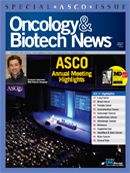Publication
Article
Oncology & Biotech News
ASCO 2010: Opaxio Highly Active in Esophageal Cancer
Author(s):
A drug that delivers paclitaxel in a novel way has yielded favorable results in a phase II trial of patients with advanced esophageal cancer, prompting the company developing the drug to plan a phase III trial.
A drug that delivers paclitaxel in a novel way has yielded favorable results in a phase II trial of patients with advanced esophageal cancer, prompting the company developing the drug to plan a phase III trial. No tumors were found in 38% of patients with advanced esophageal cancer who received paclitaxel poliglumex (CT-2103; Opaxio) as part of a combination regimen before surgery, according to research presented in a poster session.
Paclitaxel poliglumex links paclitaxel to the biodegradable polymer polyglutamate to form a new chemical, said Cell Therapeutics Inc (CTI), the drug’s manufacturer. Based on preclinical studies, the drug distributes preferentially to tumors. This allows significantly more of the active chemotherapy agent to localize in the tumor and reduces toxic effects to normal organs.
In the phase II, single-arm study, paclitaxel poliglumex was administered with cisplatin and radiation to 40 patients (median age, 62 y) prior to surgery. There were 37 cases of adenocarcinoma and 3 of squamous cell carcinoma of the esophagus or gastroesophageal junction. Doses of paclitaxel poliglumex at 50 mg/m2 and cisplatin at 25 mg/m2 were given weekly for 6 weeks, along with a 50.4 Gy-dose of radiation. Resection occurred 4 to 6 weeks aft er treatment.
Pathologic complete response was observed in 12 of the 37 patients (32%) who had their esophagus surgically removed. The remaining 3 patients (7.5%) declined surgery aft er complete endoscopic response. One patient required a feeding tube and one needed total outside nutrition support. No treatment-related deaths were reported, though 1 patient died during surgery fr om multisystem organ failure. No grade 4 hematologic adverse events were observed; grade 3 neutropenia, esophagitis, and allergic reaction each occurred in 6% of patients; 8% of patients developed nausea, and 3% reported fatigue.
“Opaxio significantly improved the pathologic complete response rate that has been shown in previous phase III trials using standard chemotherapy plus radiation,” said investigator Kimberly Perez, MD, of the Warren Alpert School of Medicine at Brown University, in a press release. She also noted that the drug was well tolerated.
In the United States, the standard treatment regimen for esophageal cancer is 5-fluorouracil (5-FU) plus cisplatin chemotherapy with concurrent radiation. Investigators said this regimen is associated with a pathologic complete response rate of around 15%, with 40% of patients experiencing grade 3/4 inflammation and ulcers.
"The important features of the current study are both the higher-than-historical pathological response rate—a potential excellent surrogate for long-term survival—and the dramatically lower side effects than would be expected from conventional neoadjuvant chemoradiotherapy with cisplatin and 5-FU," said Jack Singer, MD, chief medical officer of CTI, in a press release. Based on these data, CTI plans to meet with FDA officials before the end of the year to discuss a phase III registration study of Opaxio’s use in esophageal cancer. Abstract 4085.










